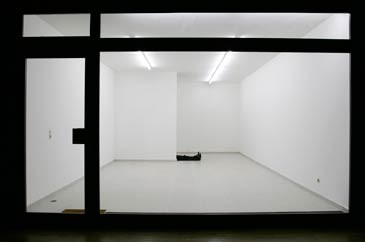Double: Reiner Ruthenbeck
07 Mar - 26 Apr 2009
DOUBLE: REINER RUTHENBECK
"Umgekippte Möbel/Upturned Furniture"
7 March - 26 April 2009
The Double exhibition series will launch with a show consisting of »Objects« by Reiner Ruthenbeck that were first displayed at the 1971 in Kabinett für aktuelle Kunst, Bremerhaven. The MMK acquired this prime example of Concept Art in 1993 as the Frankfurt version, which bears the name »Umgekippte Möbel / Upturned Furniture«.
Alongside Gerhard Richter, Sigmar Polke and Blinky Palermo, Reiner Ruthenbeck is considered one of the most influential of his generation. He studied in the early 1960s under Joseph Beuys at the Düsseldorf Academy of Art and was also a member of Beuys’ master class. With his participation in Harald Szeemann’s legendary show »When Attitudes Become Form« in Berne in 1969, Ruthenbeck established himelf on the international scene, too.
Compared with his early works from the 1960s, which rely on a repertoire of forms that, by absolutely reductionist means, carefully and precisely strikes a balance between the different sculptures, the »Objects« of 1971 truly seem to have become unbalanced.
The title clearly defines Reiner Ruthenbeck’s work: In the room, several tables, chairs, and a recliner have been distributed at random, seemingly by some unknown force or perhaps upended during an aggressive performance. Here, middle-class life as symbolized by customary furnishings seems to have got out of kilter. The result is a new, unexpected gaze at the appearance of the things that are scattered wildly here and are no longer held in place by a rigid system. Reiner Ruthenbeck thus wittily the regulated order of everyday life, which he quite literally sends reeling. He showcases objects in an unusual way and thus the presence and function usually associated with them.
Since then, Ruthenbeck has made other versions of this sculptural and site-specific ensemble, each adapted to the respective conditions. No minimum number of items of furniture is ever set. What is decisive is not the design of the respective furniture items, but the concept. The focus is on the way the items are staged, the presentation of utilitarian objects in space – indeed, one could speak here of static action. Seen as an image, the room is also comparable with a 3D cubist composition. In the case of the items Ruthenbeck chose for the show in Bremerhaven, he opted for plain utilitarian furniture.
And the pieces for the Frankfurt version were again primarily chosen for their functionality. Yet the configuration strips them precisely of that quality. The chaotic, strange spatial structure is unsettling, but also encourages viewers to break out of staid ways and possibly restructure their own lives.
"Umgekippte Möbel/Upturned Furniture"
7 March - 26 April 2009
The Double exhibition series will launch with a show consisting of »Objects« by Reiner Ruthenbeck that were first displayed at the 1971 in Kabinett für aktuelle Kunst, Bremerhaven. The MMK acquired this prime example of Concept Art in 1993 as the Frankfurt version, which bears the name »Umgekippte Möbel / Upturned Furniture«.
Alongside Gerhard Richter, Sigmar Polke and Blinky Palermo, Reiner Ruthenbeck is considered one of the most influential of his generation. He studied in the early 1960s under Joseph Beuys at the Düsseldorf Academy of Art and was also a member of Beuys’ master class. With his participation in Harald Szeemann’s legendary show »When Attitudes Become Form« in Berne in 1969, Ruthenbeck established himelf on the international scene, too.
Compared with his early works from the 1960s, which rely on a repertoire of forms that, by absolutely reductionist means, carefully and precisely strikes a balance between the different sculptures, the »Objects« of 1971 truly seem to have become unbalanced.
The title clearly defines Reiner Ruthenbeck’s work: In the room, several tables, chairs, and a recliner have been distributed at random, seemingly by some unknown force or perhaps upended during an aggressive performance. Here, middle-class life as symbolized by customary furnishings seems to have got out of kilter. The result is a new, unexpected gaze at the appearance of the things that are scattered wildly here and are no longer held in place by a rigid system. Reiner Ruthenbeck thus wittily the regulated order of everyday life, which he quite literally sends reeling. He showcases objects in an unusual way and thus the presence and function usually associated with them.
Since then, Ruthenbeck has made other versions of this sculptural and site-specific ensemble, each adapted to the respective conditions. No minimum number of items of furniture is ever set. What is decisive is not the design of the respective furniture items, but the concept. The focus is on the way the items are staged, the presentation of utilitarian objects in space – indeed, one could speak here of static action. Seen as an image, the room is also comparable with a 3D cubist composition. In the case of the items Ruthenbeck chose for the show in Bremerhaven, he opted for plain utilitarian furniture.
And the pieces for the Frankfurt version were again primarily chosen for their functionality. Yet the configuration strips them precisely of that quality. The chaotic, strange spatial structure is unsettling, but also encourages viewers to break out of staid ways and possibly restructure their own lives.

